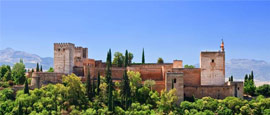Granada History
The Granada area has been populated for thousands of years. From around 1500BC, the region began to experience Phoenician, Greek, Roman and Visigothic influences. The 5th century settlement known as Elibyrge would later evolve into the Roman city of Illiberis.
In 711, Moorish groups conquered large parts of the Iberian Peninsula. The actual founding of present-day Granada occurred in the 11th century, after the end of a civil war, when a Berber general decided to establish an independent kingdom.
The small village of the time was transformed into one of the most important cities of Moorish Spain, with the fairytale palace-fortress Alhambra symbolising its peak of elegance and splendour in the 14th and 15th centuries. The most famous Moorish rule was that of the Nasrid dynasty from 13th century.
The Nasrids’ reign came to an end in 1492, when the Reconquista reached Granada, which was the final emirate to fall to the Catholic Monarchs. The Moors (and Jews) of the city were forced to convert or emigrate, resulting in the Morisco class of Arab converts.
Eventually the city’s mosques were converted to churches or destroyed, and the mighty cathedral and other buildings sprang up in their place. One of the most notable buildings was the beautiful Capilla Real which was erected as a mausoleum for the Catholic Monarchs. Streets were also widened and large squares created.
The expulsion of many Jews and Muslims caused economic decline and Granada and the Alhambra slipped into centuries of neglect. The first tourists interested in the city’s Islamic heritage started to arrive in 19th century, but Granada was then decimated in 1884 by an earthquake. The city saw resurgence in 1920s, as Granada became a centre of Spanish art, but then came the Spanish Civil War in 1930s, which resulted in Franco’s repressive dictatorship until 1975.
After Franco’s death, Granada witnessed a university boom, which helped transform the city’s economic fortunes. Massive modernisation followed, including the creation of the magnificent Science Park in 1995. Apart from being a tourist hub, today’s Granada is a thriving city with a vibrant student population.
Did you know?
• Although the Reconquista is heralded as the end of Moorish rule in Spain, Granada is in fact thought to have been a tributary state of the Spanish Kingdom of Castile as far back as 1238.
• The Alhambra, which was declared a UNESCO World Heritage Site in 1984, has its roots in an earlier 9th century fortress and was altered substantially by Charles V in 16th century.
• The year of the Reconquista was a big one for the most famous Catholic Monarch, Isabella I, as Christopher Colombus reached the New World, funded by Spain.
Do you have any Feedback about this page?
© 2025 Columbus Travel Media Ltd. All rights reserved. No part of this site may be reproduced without our written permission, click here for information on Columbus Content Solutions.




 You know where
You know where